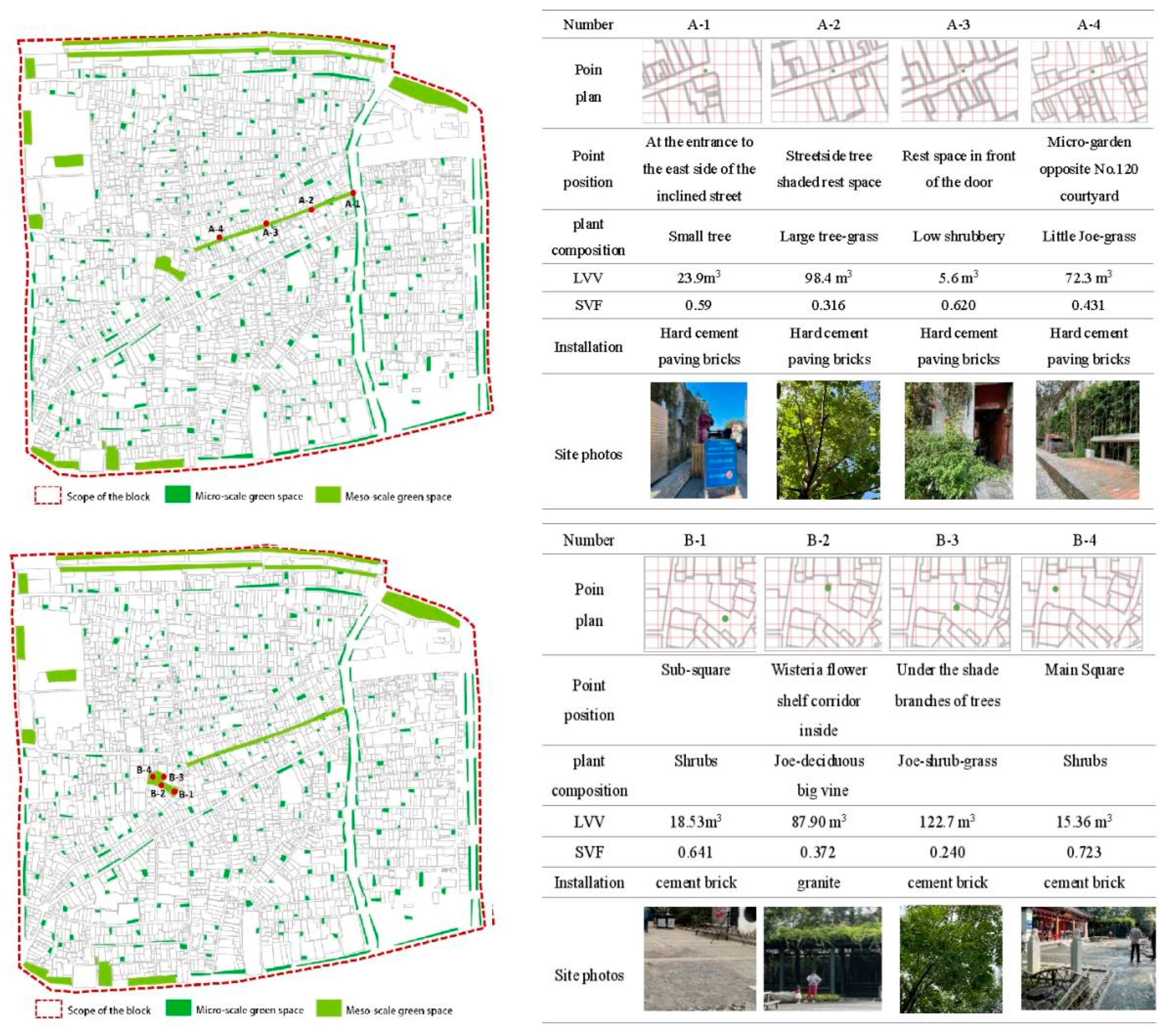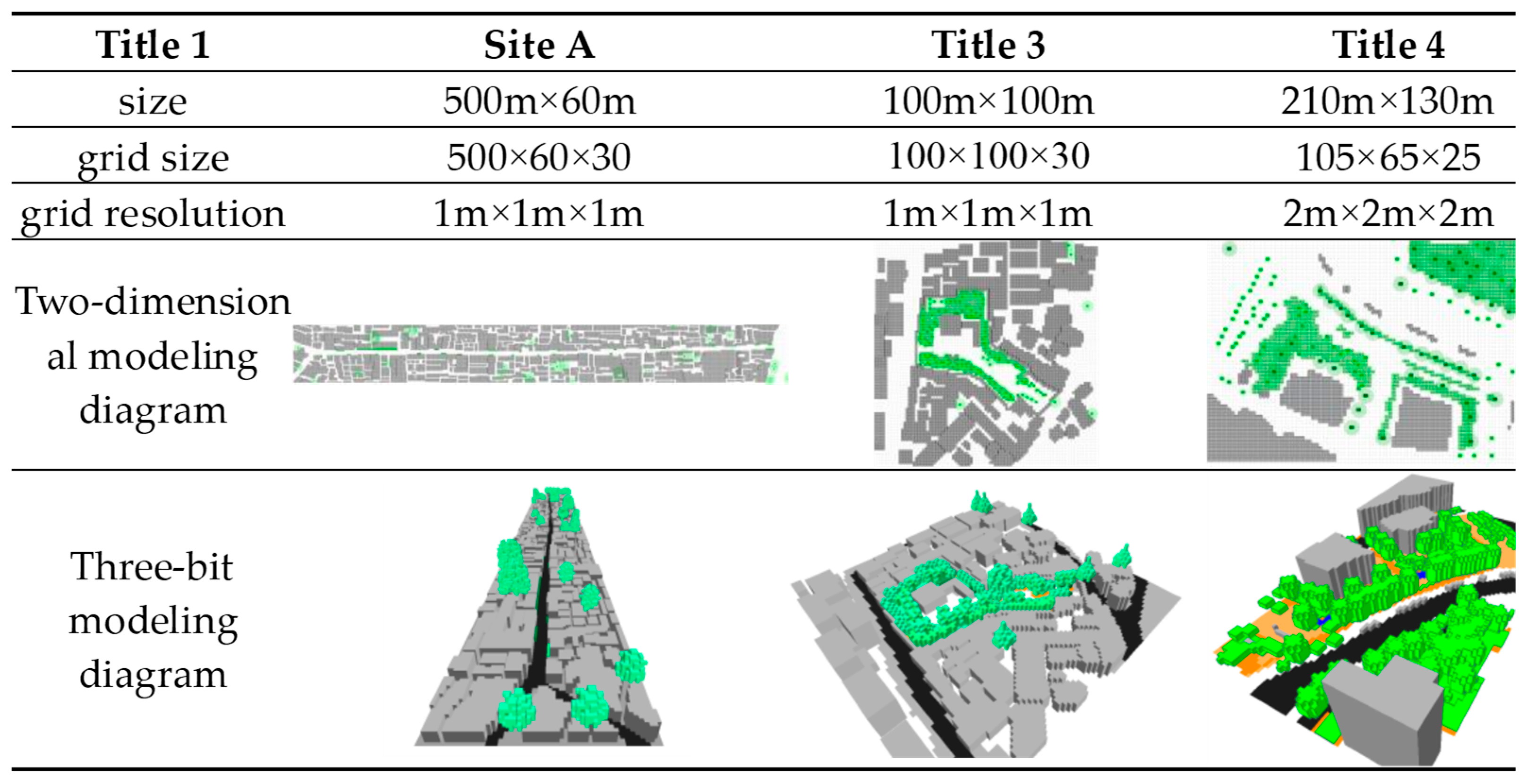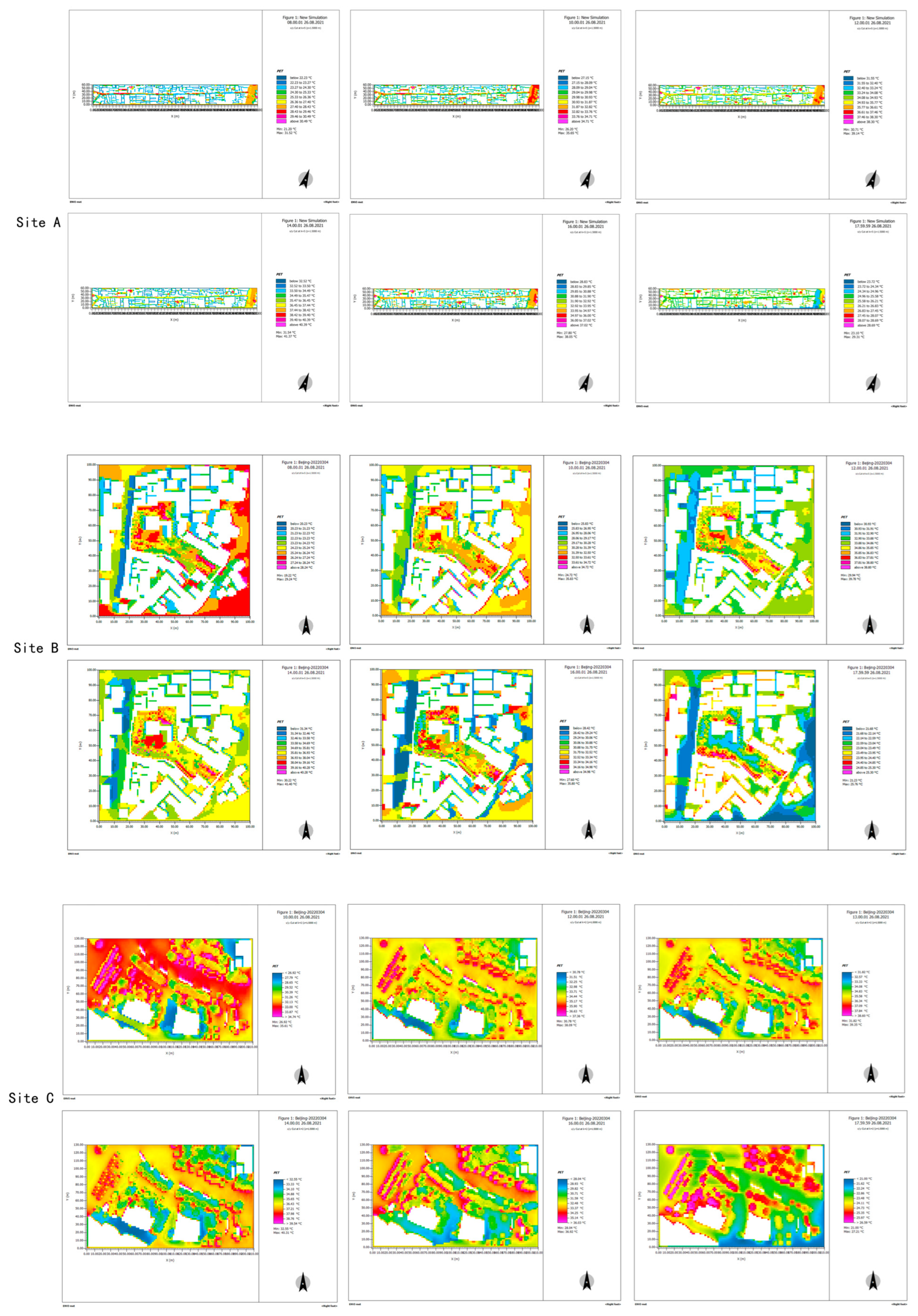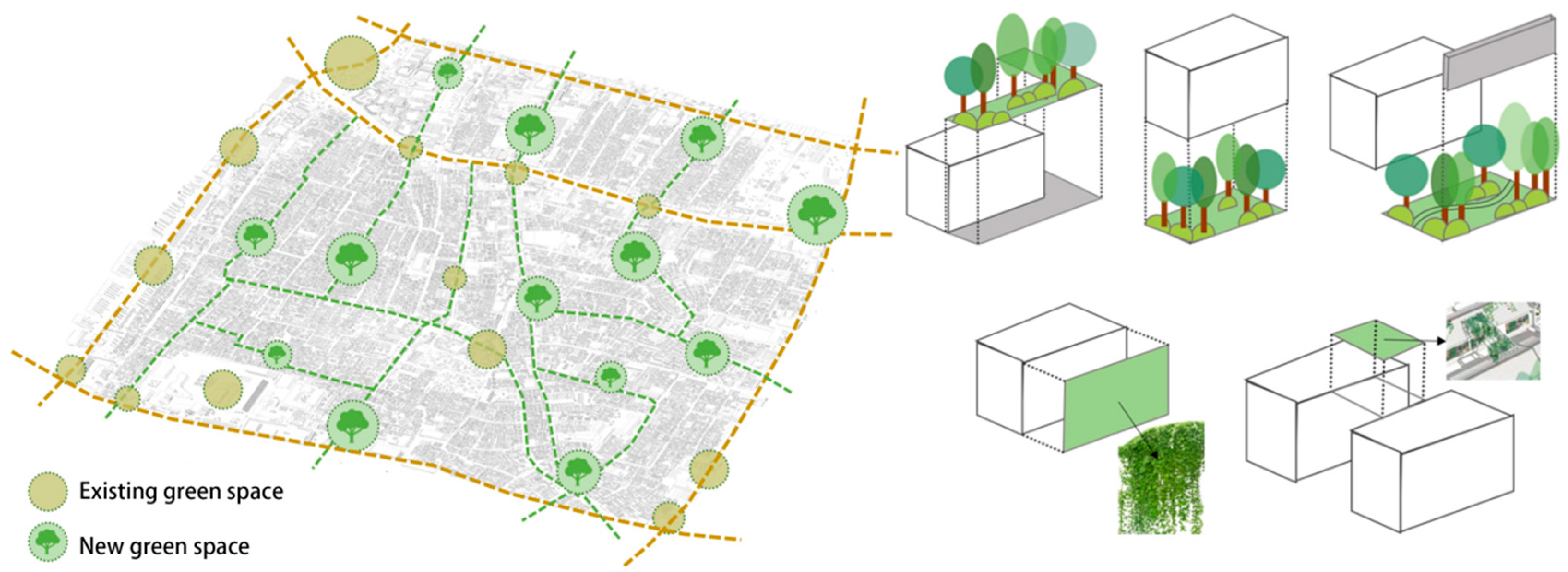Research on Thermal Comfort Evaluation and Optimization of Green Space in Beijing Dashilar Historic District
Abstract
:1. Introduction
2. Materials and Methods
2.1. Research Area
2.2. Questionnaire Survey
2.3. Envi-Met Numerical Simulation
3. Results
3.1. Microclimate Measured Results
3.1.1. Temperature Measurement
3.1.2. Anemometry
3.1.3. Relative Humidity Measurement
3.2. Questionnaire Survey
3.3. Thermal Comfort PET Simulation
3.3.1. Thermal Comfort Evaluation of Site A
3.3.2. Thermal Comfort Evaluation of Site B
3.3.3. Thermal Comfort Evaluation of Site C
3.4. Coupling Analysis of Green Space Factor and Thermal Comfort
3.4.1. The Coupling Relationship between Sky OPENNESS SVF and Thermal Comfort PET
3.4.2. Coupling Relationship between Three-Dimensional Green Quantity and Thermal Comfort PET
3.5. Summary of Influencing Factors of Thermal Comfort in Green Space
3.5.1. Three-Dimensional Green Space Green Quantity
3.5.2. Green Space Sky Openness
3.5.3. Underlying Surface of Green Space
4. Discussion
- (1)
- Due to the lack of manpower and material resources, this paper only evaluates the microclimate thermal comfort evaluation study of three typical green spaces in the Dazhalan neighborhood, which is somewhat insufficient in the number of samples. Meanwhile, due to the limitation of the number of experimental equipment, this paper adopts the method of mobile observation, ignoring the time difference in collecting data, and there is still a lack of precision.
- (2)
- The season chosen for this study is summer, mainly because the thermal environment problem is more prominent in Beijing in summer, so the study is more targeted. It is hoped that the study of microclimate comfort in the spring, autumn, and winter seasons can be added to future studies so that green space optimization strategies can be comprehensively formulated.
- (3)
- In this study, only the basic microclimate parameters were measured, and in the future, PM2.5 and PM10, which are related to air quality, can be introduced into the study of green space in Dazhalan so as to explore the coupling relationship between green space and air quality.
- (4)
- This study analyzes the thermal comfort effect of green space from the perspective of the three green amounts of plants and does not consider the influence of plant types separately, so the conclusion is not comprehensive enough. The types of trees in Dazhalan are relatively homogeneous, so they were not categorized in detail. Future studies should take this into account.
5. Conclusions
5.1. Optimize the Layout and Construction Mode of Green Space
5.2. Reasonable Collocation of Green Planting
5.3. Improve the Underlying Surface Pavement of the Block
Author Contributions
Funding
Data Availability Statement
Conflicts of Interest
References
- Xie, B.; Wang, X.; Wu, L. Exploring the effect of urban greenspace on residents’ mental health using aquasi-natural experiment: Taking Wuhan East Lake Greenway as an example. Prog. Geogr. 2021, 40, 1141–1153. [Google Scholar] [CrossRef]
- Xiong, W.; Zhu, J.; Yan, J.; Guo, Y.; Sun, H. A preliminary discussion on the humanistic governance of Dashilar Street for safety and health. Beijing Plan. Rev. 2020, 7, 153–159. [Google Scholar]
- Yang, X.; He, S.; Lu, X. Research on thermal comfort valuation of Public space in Beuing old city based on software simulation: A case study of six alleys in Baite temple area. Urban. Archit. 2018, 51–56. [Google Scholar] [CrossRef]
- Thompson, C.W. Urban Open space in the 21st century. Landsc. Urban Plan. 2002, 60, 59–72. [Google Scholar] [CrossRef]
- Mahyar, M.; Puay, Y. Multi-year comparison of the effects of spatial pattern of urban green spaces on urban land surface temperature. Landsc. Urban Plan. 2019, 184, 44–58. [Google Scholar]
- Widayati, A.; Louman, B.; Mulyoutami, E.; Purwanto, E.; Kusters, K.; Zagt, R. Communities’ Adaptation and Vulnerability to Climate Change: Implications for Achieving a Climate-Smart Landscape. Land 2021, 10, 816. [Google Scholar] [CrossRef]
- Reza, R.; Esmaeil, Z.; Margaret, B. Spatio-temporal planning of urban neighborhoods in the context of global climate change: Lessons for urban form design in Tehran, Iran. Sustain. Cities Soc. 2019, 51, 101554. [Google Scholar]
- Alcazar, S.S.; Olivieri, F.; Neila, J. Green Roofs: Experimental and Analytical Study of Its Potential for Urban Microclimate Regulation in Mediterranean–continental Climates. Urban Clim. 2016, 17, 304–317. [Google Scholar] [CrossRef]
- Shashua-Bar, L.; Pearlmutter, D.; Erell, E. The influence of trees and grass on outdoor thermal comfort in a hot-arid environment. Int. J. Climatol. J. R. Meteorol. Soc. 2011, 31, 1498–1506. [Google Scholar] [CrossRef]
- Huttner, S.; Bruse, M.; Dostal, P. Using ENVI-met to simulate the impact of global warming on the mi-croclimate in central European cities. Ber. Meteorol. Inst. Univ. Freiburg. 2008, 18, 97–103. [Google Scholar]
- Fu, F.; Zhao, C.; Sun, Y.; Liu, D.; Li, Y. Study on the Relationship between Temperature, Humidity and Particular Matters in Green Spaces inAutumn: A Case Study of Yuyuantan Park, Beijing. Chin. Landsc. Archit. 2018, 34, 36–40. [Google Scholar]
- Dai, F.; Bi, S.; Chen, M. Analysis of frontier research on urban green space based on general program of the national natural science fund of china: Hot spots and methods. Landsc. Archit. 2021, 28, 10–15. [Google Scholar]
- Chen, M.; Dai, F. The influence of urban green spaces on thermal environment based on morphological spatial pattern analysis. Ecol. Environ. Sci. 2021, 30, 125–134. [Google Scholar]
- Wu, S. Microclimate Effect of Urban Green Space and Its Influence on Human Comfort. Master’s Thesis, Beijing Forestry University, Beijing, China, 2019. [Google Scholar]
- Middel, A.; Selover, N.; Hagen, B.; Chhetri, N. Impact of shade on outdoor thermal comfort—A seasonal field study in Tempe, Arizona. Int. J. Biometeorol. 2016, 60, 1849–1861. [Google Scholar] [CrossRef]
- Klemm, W.; Heusinkveld, B.; Lenzholzer, S.; Hove, B. Street greenery and its physical and psychological impact on thermal comfort. Landsc. Urban Plan. 2015, 138, 87–98. [Google Scholar] [CrossRef]
- Liu, B.; Li, C. Evaluation of Microclimate Suitability of Landscape Space in Shihua Jincheng, Shanghai. Landscape gardening and microclimate. In Proceedings of the Second International Symposium on Landscape Gardening and Microclimate in China, Chongqing, China, 17 January 2020; pp. 112–118. [Google Scholar]
- Morakinyo, T.; Yun, F. Simulation study on the impact of tree-configuration, planting pattern and wind condition on street-canyon’s micro-climate and thermal comfort. Build. Environ. 2016, 103, 262–275. [Google Scholar] [CrossRef]
- Yang, Y.; Tang, X.; Ji, Q.; Sun, M. Numerical simulation of the microclimate environment in typical historic blocks of Nanjing based on ENVl-met. J. Suzhou Univ. Sci. Technol. Eng. Technol. Ed. 2018, 31, 33–40. [Google Scholar]
- Xiong, Y.; Yan, Y. Effects of spatial design and microclimate on human thermal comfort in the region south of the Yangtze River: A case study of old street in Gaochun Nanjing. J. Nanjing For. Univ. 2021, 45, 219–226. [Google Scholar]
- Qi, L.; Ma, Z.; Guo, Y.; Liu, J.; Song, Z. Study on the mountain-water patterns of Xijingyu Village in Jizhou District, Tianjin Based on the comprehensive analysis of micro-climate adaptability and design mechanism. Chin. Landsc. Archit. 2018, 34, 34–41. [Google Scholar]
- Cohen, P.; Potchter, O.; Matzarakis, A. Daily and seasonal climatic conditions of green urban open spaces in the Mediterranean climate and their impact on human comfort. Build. Environ. 2012, 51, 285–295. [Google Scholar] [CrossRef]
- Lim, H. Measuring and Modelling Spatial Variation of Temperature and Thermal Comfort in a Low-Density Neighbourhood in Singapore. Master’s Thesis, National University of Singapore, Singapore, 2014. [Google Scholar]
- Wu, R.; Yan, H.; Shu, Y.; Shi, Y.; Bao, Z. Microclimatic Characteristics and Human ComfortConditions of Bamboo Plant Communities in Summer. Chin. Landsc. Archit. 2019, 35, 112–117. [Google Scholar]
- Xiao, Y.; Xue, S. Outdoor Thermal Comfort Threshold of Lingnan Gardenin Summer. Build. Sci. 2016, 32, 1–9+17. [Google Scholar]
- Qi, L.; Liu, R.; Cui, Y.; Zhou, M.; Song, Z. Study of the landscape pattern of Shuiyu village in Beijing, China: A comprehensive analysis of adaptation to local microclimate. Sustainability 2021, 14, 375. [Google Scholar] [CrossRef]
- Chen, L.; Wen, Y.; Zhang, L.; Xiang, W. Studies of thermal comfort and space use in an urban park square in cool and cold seasons in Shanghai. Build. Environ. 2015, 94, 644–653. [Google Scholar] [CrossRef]
- Liu, B.; Wei, D. Review and prospect of thermal comfort in green space. Planners 2017, 33, 102–107. [Google Scholar]
- Xiong, W.; Yan, W.; Liu, X.; Ma, R. The Improvement of spatial quality on Beuing historical streets based on people-oriented observation. Urban. Archit. 2018, 6, 57–61. [Google Scholar]
- Lai, H. Study on Microclimate Effects of Urban Green Space Plant Communities in Hot and Humid Regions: A Case Study of Guangzhou Campus Green Space. Master’s Thesis, South China University of Technology, Guangzhou, China, 2019. [Google Scholar]
- He, S. Research on Current Situation and Optimization Strategy of Street Thermal Comfort in Beijing Old Town Historic Block. Master’s Thesis, North China University of Technology, Beijing, China, 2019. [Google Scholar]
- Dong, Y.; Zhang, Z.; Sun, S.; Wang, Q.; Liu, X. Thermal comfort evaluation of activity space in urban comprehensive parks based on microclimate simulation: A case study of Wanliutang Park in Shenyang City. J. Hum. Settl. West China 2023, 38, 15–21. [Google Scholar]
- Yan, Y.; Yue, S.; Liu, X.; Wang, D.; Chen, H. Advances in Assessment of Bioclimatic ComfortConditions at Home and Abroad. Adv. Earth Sci. 2013, 28, 1119–1125. [Google Scholar]
- Tao, Y. Evaluation and Optimization of Thermal Comfort in Micro Green Space at High Temperature: A Case Study of Yuzhong District, Chongqing. Master’s Thesis, Chongqing University, Chongqing, China, 2019. [Google Scholar]
- Xu, H.; Zhu, J.; Li, H. Optimization design of summer microclimate adaptability of urban campus green space based on ENVl-met Simulation. Mod. Urban Res. 2023, 38, 101–106+114. [Google Scholar]
- Hou, X. Research and practice on green micro-renewal of micro-garden in Beijing Old City. Beijing Plan. Rev. 2019, 161–169. [Google Scholar]
- Wei, X.; Hao, R.; Zhang, M.; Shen, H.; Qiu, Y.; Geng, H. Microclimate changes with simulated canopy spatial structures. J. Zhejiang A F Univ. 2019, 36, 783–792. [Google Scholar]
- Wu, Y. The Research on Microclimate Effect of the Three-Dimensional Morphology on Urban Waterfront Green Space Vegetation. Master’s Thesis, East China Normal University, Shanghai, China, 2020. [Google Scholar]







Disclaimer/Publisher’s Note: The statements, opinions and data contained in all publications are solely those of the individual author(s) and contributor(s) and not of MDPI and/or the editor(s). MDPI and/or the editor(s) disclaim responsibility for any injury to people or property resulting from any ideas, methods, instructions or products referred to in the content. |
© 2024 by the authors. Licensee MDPI, Basel, Switzerland. This article is an open access article distributed under the terms and conditions of the Creative Commons Attribution (CC BY) license (https://creativecommons.org/licenses/by/4.0/).
Share and Cite
Qi, L.; Li, T.; Chang, B.; Xiong, W. Research on Thermal Comfort Evaluation and Optimization of Green Space in Beijing Dashilar Historic District. Buildings 2024, 14, 3121. https://doi.org/10.3390/buildings14103121
Qi L, Li T, Chang B, Xiong W. Research on Thermal Comfort Evaluation and Optimization of Green Space in Beijing Dashilar Historic District. Buildings. 2024; 14(10):3121. https://doi.org/10.3390/buildings14103121
Chicago/Turabian StyleQi, Ling, Tianjing Li, Biyun Chang, and Wen Xiong. 2024. "Research on Thermal Comfort Evaluation and Optimization of Green Space in Beijing Dashilar Historic District" Buildings 14, no. 10: 3121. https://doi.org/10.3390/buildings14103121
APA StyleQi, L., Li, T., Chang, B., & Xiong, W. (2024). Research on Thermal Comfort Evaluation and Optimization of Green Space in Beijing Dashilar Historic District. Buildings, 14(10), 3121. https://doi.org/10.3390/buildings14103121




